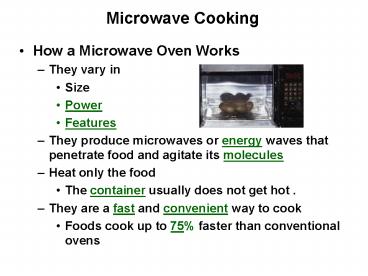Microwave Cooking - PowerPoint PPT Presentation
1 / 9
Title:
Microwave Cooking
Description:
Using a Microwave Oven Amount of power is measured in watts. Most microwaves use a maximum of 500-700 watts. The higher the wattage, the faster foods will cook. – PowerPoint PPT presentation
Number of Views:761
Avg rating:3.0/5.0
Title: Microwave Cooking
1
Microwave Cooking
- How a Microwave Oven Works
- They vary in
- Size
- Power
- Features
- They produce microwaves or energy waves that
penetrate food and agitate its molecules - Heat only the food
- The container usually does not get hot .
- They are a fast and convenient way to cook
- Foods cook up to 75 faster than conventional
ovens
2
- Used to
- Reheat leftovers
- Cook food
- Defrost frozen food
- Thawing or unfreezing frozen foods
- Microwaves use less electricity.
- Nutrients in food are better preserved.
- Quick cooking time
- Foods such as vegetables require little or no
added water.
3
- Using a Microwave Oven
- Amount of power is measured in watts.
- Most microwaves use a maximum of 500-700 watts.
- The higher the wattage, the faster foods will
cook. - Choosing Cookware
- Containers should be labeled microwave safe.
- Dont get too hot
- Dont melt
- Dont crack
- Dont shatter
4
- Round containers allow more even cooking.
- Metal containers should never be used.
- Aluminum foil should not be used as a cover.
- Microwaves cant pass through metal.
- Metal can cause arcing.
- Electrical sparks that can damage a microwave and
start a fire. - Brown paper bags and other products from recycled
paper should also be avoided. - They can catch fire.
5
- Cooking Preparation
- Choose a container that will fit into the
microwave. - Use containers with extra space so foods wont
boil over. - Arrange the food so that it can heat up or cook
evenly. - Cut into pieces of the same size.
- Place thickest pieces toward the outside of the
container. - That is where the most energy is.
6
- Use a fork or knife to pierce foods that are
encased in a skin. - Whole potatoes
- Hotdogs
- Cover foods so they hold in moisture and do not
spatter. - Paper towels
- Waxed paper
- Plastic wrap
- Covers that come with microwavable containers
- Cover food loosely to let steam escape.
7
- The Cooking Process
- Stirring
- Soups and stews to cook evenly.
- The outside cooks first.
- Stir outer edges toward the center.
- Rearranging
- Some foods might have to be turned after a few
minutes. - Baking potatoes
- Rotating
- Turning the dish a quarter-turn or a half-turn.
- Follow package directions.
- Some microwaves have a turntable that
automatically rotates whenever the oven is in
use. - Standing Time
- To let temperatures equalize
- Very important
- Foods continue cooking
8
- Variables in Microwave Cooking
- Conditions that determine how long a food needs
to be cooked and at what power level. - Density
- The denser the food, the longer it takes to cook.
- Heavy for its size
- Volume of food
- Amount or number of servings determines power and
time needed. - Small amounts cook faster.
- Shape of food
- Round foods cook more evenly than foods with
corners. - Thin pieces cook more quickly than thick pieces.
- Temperature of food
- If at room temperature, it will heat faster than
food taken from the refrigerator or freezer.
9
- Safe Use of Microwave Ovens
- To avoid fires and other accidents
- Use dishes labeled microwave safe.
- Remove covers slowly after food is cooked
- Tilt the cover or remove plastic wrap so that
steam escapes away from you. - Dont microwave foods in containers that are
completely sealed. - Pressure from steam builds and the container
could burst. - Dont use an extension cord with a microwave.
- Give it its own outlet.
- If the oven door does not close tightly or if you
hear unusual sounds coming from the oven, tell an
adult. - If there are sparks inside the oven or if there
is a fire - Turn off the oven or unplug it immediately and
get help. - Microwaves are generally safe to use.

